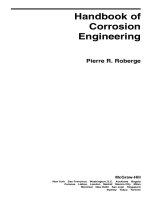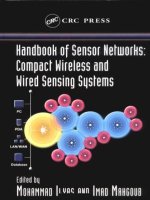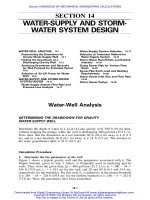Tài liệu Handbook of Sensor Networks P1 ppt
Bạn đang xem bản rút gọn của tài liệu. Xem và tải ngay bản đầy đủ của tài liệu tại đây (1.49 MB, 40 trang )
1968title 6/18/04 12:34 PM Page 1
Handbook of Sensor Networks:
Compact Wireless and
Wired Sensing Systems
CRC PRESS
Boca Raton London New York Washington, D.C.
Edited by
M
OHAMMAD
I
LYAS
AND
I
MAD
M
AHGOUB
This book contains information obtained from authentic and highly regarded sources. Reprinted material is quoted with
permission, and sources are indicated. A wide variety of references are listed. Reasonable efforts have been made to publish
reliable data and information, but the author and the publisher cannot assume responsibility for the validity of all materials
or for the consequences of their use.
Neither this book nor any part may be reproduced or transmitted in any form or by any means, electronic or mechanical,
including photocopying, microÞlming, and recording, or by any information storage or retrieval system, without prior
permission in writing from the publisher.
All rights reserved. Authorization to photocopy items for internal or personal use, or the personal or internal use of speciÞc
clients, may be granted by CRC Press LLC, provided that $1.50 per page photocopied is paid directly to Copyright Clearance
Center, 222 Rosewood Drive, Danvers, MA 01923 USA. The fee code for users of the Transactional Reporting Service is
ISBN 0-8493-1968-4/05/$0.00+$1.50. The fee is subject to change without notice. For organizations that have been granted
a photocopy license by the CCC, a separate system of payment has been arranged.
The consent of CRC Press LLC does not extend to copying for general distribution, for promotion, for creating new works,
or for resale. SpeciÞc permission must be obtained in writing from CRC Press LLC for such copying.
Direct all inquiries to CRC Press LLC, 2000 N.W. Corporate Blvd., Boca Raton, Florida 33431.
Trademark Notice:
Product or corporate names may be trademarks or registered trademarks, and are used only for
identiÞcation and explanation, without intent to infringe.
Visit the CRC Press Web site at www.crcpress.com
© 2005 by CRC Press LLC
No claim to original U.S. Government works
International Standard Book Number 0-8493-1968-4
Library of Congress Card Number 2004043852
Printed in the United States of America 1 2 3 4 5 6 7 8 9 0
Printed on acid-free paper
Library of Congress Cataloging-in-Publication Data
Handbook of sensor networks : compact wireless and wired sensing systems / edited by
Mohammad Ilyas and Imad Mahgoub.
p. cm.
Includes bibliographical references and index.
ISBN 0-8493-1968-4 (alk. paper)
1. Sensor networks. 2. Wireless LANs. I. Ilyas, Mohammad, 1953- II. Mahgoub, Imad.
TK7872.D48.H36 2004
004.6
′
8—dc22 2004043852
1968_C00.fm Page iv Monday, June 14, 2004 11:23 AM
Copyright © 2005 by CRC Press LLC
Preface
As the field of communications networks continues to evolve, a very interesting and challenging area —
wireless sensor networks — is rapidly coming of age. A wireless sensor network consists of a large number
of sensor nodes that may be randomly and densely deployed. Sensor nodes are small electronic compo-
nents capable of sensing many types of information from the environment, including temperature; light;
humidity; radiation; the presence or nature of biological organisms; geological features; seismic vibra-
tions; specific types of computer data; and more. Recent advancements have made it possible to make
these components small, powerful, and energy efficient and they can now be manufactured cost-effectively
in quantity for specialized telecommunications applications. Very small in size, the sensor nodes are
capable of gathering, processing, and communicating information to other nodes and to the outside
world. Based on the information handling capabilities and compact size of the sensor nodes, sensor
networks are often referred to as “smart dust.”
Sensor networks have numerous applications, including health; agriculture; geology; retail; military;
home; and emergency management. Sensor network research and development derive many concepts
and protocols from distributed computer networks such as the Internet; however, several technical
challenges in sensor networks need to be addressed due to the specialized nature of the sensors and the
fact that many sensor network applications may involve remote mobile sensors with limited power sources
that must dynamically adapt to their environment. This handbook proposes to capture the current state
of sensor networks and to serve as a source of comprehensive reference material on them.
The handbook has a total of 40 chapters written by experts from around the world and is divided into
the following nine sections:
1. Introduction
2. Applications
3. Architecture
4. Protocols
5. Tracking technologies
6. Data gathering and processing
7. Energy management
8. Security, reliability, and fault tolerance
9. Performance and design aspects
The targeted audience for this handbook include
s professionals who are designers and/or planners for
emerging telecommunication networks; researchers (faculty members and graduate students); and those
who would like to learn about this field.
This handbook provides technical information about various aspects of sensor networks, networks
comprising multiple compact, intercommunicating electronic sensors. The areas covered range from
1968_C00.fm Page v Monday, June 14, 2004 11:23 AM
Copyright © 2005 by CRC Press LLC
basic concepts to research-grade material, including future directions. This handbook should serve as a
complete reference material for sensor networks.
The
Handbook of Sensor Networks
has the following specific salient features:
•It serves as a single comprehensive source of information and as reference material on wireless
sensor networks.
•It deals with an important and timely topic of emerging communication technology of tomorrow.
•It presents accurate, up-to-date information on a broad range of topics related to wireless sensor
networks.
•It presents material authored by experts in the field.
•It presents the information in an organized and well-structured manner.
•Although it is not precisely a textbook, it can certainly be used as one for graduate courses and
research-oriented courses that deal with wireless sensor networks. Any comments from the readers
will be highly appreciated.
Many people have contributed to this handbook in their unique ways. The first and the foremost group
that deserves immense gratitude is the highly talented and skilled researchers who have contributed 40
chapters to this handbook. All of them have been extremely cooperative and professional. It has also
been a pleasure to work with Nora Konopka and Helena Redshaw of CRC Press; we are extremely grateful
for their support and professionalism. We also thank Sophie Kirkwood and Gail Renard in the CRC
production department. Our families have extended their unconditional love and strong support
throughout this project and they all deserve very special thanks.
Mohammad Ilyas and Imad Mahgoub
Boca Raton, Florida
1968_C00.fm Page vi Monday, June 14, 2004 11:23 AM
Copyright © 2005 by CRC Press LLC
Editors
Mohammad Ilyas
, Ph.D., received his B.Sc. degree in electrical engineering from the University of
Engineering and Technology, Lahore, Pakistan, in 1976. From March 1977 to September 1978, he worked
for the Water and Power Development Authority in Pakistan. In 1978, he was awarded a scholarship for
his graduate studies and he completed his M.S. degree in electrical and electronic engineering in June
1980 at Shiraz University, Shiraz, Iran. In September 1980, he joined the doctoral program at Queen’s
University in Kingston, Ontario, Canada; he completed his Ph.D. degree in 1983. Dr. Ilyas’ doctoral
research was about switching and flow control techniques in computer communication networks. Since
September 1983, he has been with the College of Engineering at Florida Atlantic University, Boca Raton,
Florida, where he is currently associate dean for graduate studies and research. From 1994 to 2000, he
was chair of the department. During the 1993–1994 academic year, he was on his sabbatical leave with
the Department of Computer Engineering, King Saud University, Riyadh, Saudi Arabia.
Dr. Ilyas has conducted successful research in various areas, including traffic management and con-
gestion control in broadband/high-speed communication networks; traffic characterization; wireless
communication networks; performance modeling; and simulation. He has published one book, three
handbooks, and over 140 research articles. He has supervised 10 Ph.D. dissertations and more than 35
M.S. theses to completion. Dr. Ilyas has been a consultant to several national and international organi-
zations; a senior member of IEEE, he is an active participant in several IEEE technical committees and
activities.
Imad Mahgoub
, Ph.D., received his B.Sc. degree in electrical engineering from the University of Khar-
toum, Khartoum, Sudan, in 1978. From 1978 to 1981, he worked for the Sudan Shipping Line Company,
Port Sudan, Sudan, as an electrical and electronics engineer. He received his M.S. in applied mathematics
in 1983 and his M.S. in electrical and computer engineering in 1986, both from North Carolina State
University. In 1989, he received his Ph.D. in computer engineering from The Pennsylvania State University.
Since August 1989, Dr. Mahgoub has been with the College of Engineering at Florida Atlantic Uni-
versity, Boca Raton, Florida, where he is currently professor of computer science and engineering. He is
the director of the Computer Science and Engineering Department Mobile Computing Laboratory at
Florida Atlantic University.
Dr. Mahgoub has conducted successful research in various areas, including mobile computing; inter-
connection networks; performance evaluation of computer systems; and advanced computer architecture.
He has published over 70 research articles and supervised three Ph.D. dissertations and 18 M.S. theses
to completion. He has served as a consultant to industry.
Dr. Mahgoub served as a member of the
executive committee/program committee of
the 1998, 1999, and 2000 IEEE International Performance,
Computing and Communications Conferences.
He has served on the program committees of several
international conferences and symposia. He is currently the vice chair of the 2004 International Sympo-
sium on Performance Evaluation of Computer and Telecommunication Systems. Dr. Mahgoub is a senior
member of IEEE and a member of ACM.
1968_C00.fm Page vii Monday, June 14, 2004 11:23 AM
Copyright © 2005 by CRC Press LLC
Contributors
T. Abdelzaher
University of Virginia
Charlottesville, Virginia
Özgür B. Akan
Georgia Institute of
Technology
Atlanta, Georgia
Jamal N. Al-Karaki
Iowa State University
Ames, Iowa
Petr Benes
Brno University of
Technology
Brno, Czech Republic
Jan Beutel
Swiss Federal Institute of
Technology
Zurich, Switzerland
B. Blum
University of Virginia
Charlottesville, Virginia
Cristian Borcea
Rutgers University
Piscataway, New Jersey
Jacir L. Bordim
ATR — Adaptive
Communications Research
Laboratories
Kyoto, Japan
Athanassios Boulis
University of California at
Los Angeles
Los Angeles, California
Richard R. Brooks
The Pennsylvania State
University
State College, Pennsylvania
Mihaela Cardei
Florida Atlantic University
Boca Raton, Florida
Erdal Cayirci
Istanbul Technical University
Istanbul, Turkey
Krishnendu Chakrabarty
Duke University
Durham, North Carolina
Anantha Chandrakasan
Engim, Inc.
Acton, Massachusetts
Duminda
Dewasurendra
Virginia Polytechnic Institute
and State University
Blacksburg, Virginia
Jessica Feng
University of California at Los
Angeles
Los Angeles, California
Kurt Fristrup
Cornell Laboratory of
Ornithology
Ithaca, New York
Vincente
González–Millán
University of Valencia
Valencia, Spain
Joel I. Goodman
MIT Lincoln Laboratory
Lexington, Massachusetts
Zygmunt J. Haas
Cornell University
Ithaca, New York
Martin Haenggi
University of Notre Dame
Notre Dame, Indiana
Hossam Hassanein
Queen’s University
Kingston, Ontario, Canada
T. He
University of Virginia
Charlottesville, Virginia
Chi-Fu Huang
National Chiao-Tung University
Hsin-Chu, Taiwan
Liviu Iftode
Rutgers University
Piscataway, New Jersey
1968_C00.fm Page ix Monday, June 14, 2004 11:23 AM
Copyright © 2005 by CRC Press LLC
S. Sitharama Iyengar
Louisiana State University
Baton Rouge, Louisiana
Chaiporn Jaikaeo
University of Delaware
Newark, Delaware
Ram Kalidindi
Louisiana State University
Baton Rouge, Louisiana
Ahmed E. Kamal
Iowa State University
Ames, Iowa
Porlin Kang
Rutgers University
Piscataway, New Jersey
Rajgopal Kannan
Louisiana State University
Baton Rouge, Louisiana
Zdravko Karakehayov
Technical University of Sofia
Sofia, Bulgaria
Farinaz Koushanfar
University of California at
Berkeley
Berkeley, California
Sheng-Po Kuo
National Chiao-Tung University
Hsin-Chu, Taiwan
Baohua Li
Sichuan University
Chengdu, Sichuan, China
Xiang-Yang Li
Illinois Institute of Technology
Chicago, Illinois
Alvin S. Lim
Auburn University
Auburn, Alabama
Malin Lindquist
Örebro University
Örebro, Sweden
Antonio A.F. Loureiro
Federal University of Minas
Gerais
Belo Horizonte, Brazil
Amy Loutfi
Örebro University
Örebro, Sweden
Chenyang Lu
University of Washington at
St. Louis
St. Louis, Missouri
David R. Martinez
MIT Lincoln Laboratory
Lexington, Massachusetts
Amitabh Mishra
Virginia Polytechnic Institute
and State University
Blacksburg, Virginia
Koji Nakano
Hiroshima University
Higashi-Hiroshima, Japan
Eric Nettleton
The University of Sydney
New South Wales, Australia
José Marcos Nogueira
Federal University of Minas
Gerais
Belo Horizonte, Brazil
Lee Ling (Sharon) Ong
The University of Sydney
New South Wales, Australia
Symeon Papavassiliou
New Jersey Institute of
Technology
Newark, New Jersey
Dragan Petrovic
University of California at
Berkeley
Berkeley, California
Miodrag Potkonjak
University of California at
Los Angeles
Los Angeles, California
Alejandro Purgue
Cornell Laboratory of
Ornithology
Ithaca, New York
Gang Qu
University of Maryland
College Park, Maryland
Jan M. Rabaey
University of California at
Berkeley
Berkeley, California
Nageswara S.V. Rao
Oak Ridge National
Laboratory
Oak Ridge, Tennessee
Lydia Ray
Louisiana State University
Baton Rouge, Louisiana
Albert I. Reuther
MIT Lincoln Laboratory
Lexington, Massachusetts
1968_C00.fm Page x Monday, June 14, 2004 11:23 AM
Copyright © 2005 by CRC Press LLC
Matthew Ridley
The University of Sydney
New South Wales, Australia
Linnyer Beatrys Ruiz
Pontifical Catholic University
of Paraná
Curitiba, Brazil
and Federal University of
Minas Gerais
Belo Horizonte, Brazil
Ayad Salhieh
Wayne State University
Detroit, Michigan
Enrique Sanchis-Peris
University of Valencia
Valencia, Spain
Alberto Sangiovanni-
Vincentelli
University of California at
Berkeley
Berkeley, California
Loren Schwiebert
Wayne State University
Detroit, Michigan
Rahul C. Shah
University of California at
Berkeley
Berkeley, California
Chien-Chung Shen
University of Delaware
Newark, Delaware
Amit Sinha
Engim, Inc.
Acton, Massachusetts
Sasha Slijepcevic
University of California at
Los Angeles
Los Angeles, California
Tara Small
Cornell University
Ithaca, New York
S. Son
University of Virginia
Charlottesville, Virginia
Chavalit
Srisathapornphat
University of Delaware
Newark, Delaware
John Stankovic
University of Virginia
Charlottesville, Virginia
Weilian Su
Georgia Institute of
Technology
Atlanta, Georgia
Saleh Sukkarieh
The University of Sydney
New South Wales, Australia
Miroslav Sveda
Brno University of
Technology
Brno, Czech Republic
Vishnu Swaminathan
Duke University
Durham, North Carolina
Yu-Chee Tseng
National Chiao-Tung
University
Hsin-Chu, Taiwan
Radimir Vrba
Brno University of
Technology
Czech Republic
Quanhong Wang
Queen’s University
Kingston, Ontario, Canada
Yu Wang
Illinois Institute of
Technology
Chicago, Illinois
Brett Warneke
Dust Networks
Berkeley, California
Peter Wide
Örebro University
Örebro, Sweden
Jennifer L. Wong
University of California at Los
Angeles
Los Angeles, California
Anthony D. Wood
University of Virginia
Charlottesville, Virginia
Jie Wu
Florida Atlantic University
Boca Raton, Florida
Qishi Wu
Oak Ridge National
Laboratory
Oak Ridge, Tennessee
Kenan Xu
Queen’s University
Kingston, Ontario,
Canada
1968_C00.fm Page xi Monday, June 14, 2004 11:23 AM
Copyright © 2005 by CRC Press LLC
Mark Yarvis
Intel Corporation
Hillsboro, Oregon
Wei Ye
University of Southern
California
Los Angeles, California
Lin Yuan
University of Maryland
College Park, Maryland
Frantisek Zezulka
Brno University of Technology
Brno, Czech Republic
Jin Zhu
New Jersey Institute of
Technology
Newark, New Jersey
Mengxia Zhu
Louisiana State University
Baton Rouge, Louisiana
Yunmin Zhu
Sichuan University
Chengdu, Sichuan, China
Yi Zou
Duke University
Durham, North Carolina
1968_C00.fm Page xii Monday, June 14, 2004 11:23 AM
Copyright © 2005 by CRC Press LLC
Contents
SECTION I Introduction
1
Opportunities and Challenges in Wireless Sensor Networks
Martin Haenggi
1.1 Introduction
1.2 Opportunities
1.3 Technical Challenges
1.4 Concluding Remarks
2
Next-Generation Technologies to Enable Sensor Networks
Joel I. Goodman,
Albert I. Reuther, David R. Martinez
2.1 Introduction
2.2 Goals for Real-Time Distributed Network Computing for Sensor Data Fusion
2.3 The Convergence of Networking and Real-Time Computing
2.4 Middleware
2.5 Network Resource Management
2.6 Experimental Results
3
Sensor Network Management
Linnyer Beatrys Ruiz, José Marcos Nogueira,
Antonio A. F. Loureiro
3.1 Introduction
3.2 Management Challenges
3.3 Management Dimensions
3.4 MANNA as an Integrating Architecture
3.5 Putting It All Together
3.6 Conclusion
4
Models for Programmability in Sensor Networks
Athanassios Boulis
4.1 Introduction
4.2 Differences between Sensor Networks and Traditional Data Networks
4.3 Aspects of Efficient Sensor Network Applications
4.4 Need for Sensor Network Programmability
4.5 Major Models for System-Level Programmability
1968_C00.fm Page xiii Monday, June 14, 2004 11:23 AM
Copyright © 2005 by CRC Press LLC
4.6 Frameworks for System-Level Programmability
4.7 Conclusions
5
Miniaturizing Sensor Networks with MEMS
Brett Warneke
5.1 Introduction
5.2 MEMS Basics
5.3 Sensors
5.4 Communication
5.5 Micropower Sources
5.6 Packaging
5.7 Systems
5.8 Conclusion
6
A Taxonomy of Routing Techniques in Wireless Sensor Networks
Jamal N. Al-Karaki, Ahmed E. Kamal
6.1 Introduction
6.2 Routing Protocols in WSNs
6.3 Routing in WSNs: Future Directions
6.4 Conclusions
7
Artificial Perceptual Systems
Amy Loutfi, Malin Lindquist, Peter Wide
7.1 Introduction
7.2 Background
7.3 Modeling of Perceptual Systems
7.4 Perceptual Systems in Practice
7.5 Research Issues and Summary
SECTION II Applications
8
Sensor Network Architecture and Applications
Chien-Chung Shen, Chaiporn Jaikaeo,
Chavalit Srisathapornphat
8.1 Introduction
8.2 Sensor Network Applications
8.3 Functional Architecture for Sensor Networks
8.4 Sample Implementation Architectures
8.5 Summary
9
A Practical Perspective on Wireless Sensor Networks
Quanhong Wang,
Hossam Hassanein, Kenan Xu
9.1 Introduction
1968_C00.fm Page xiv Monday, June 14, 2004 11:23 AM
Copyright © 2005 by CRC Press LLC
9.2 WSN Applications
9.3 Classification of WSNs
9.4 Characteristics, Technical Challenges, and Design Directions
9.5 Technical Approaches
9.6 Conclusions and Considerations for Future Research
10
Introduction to Industrial Sensor Networking
Miroslav Sveda, Petr Benes,
Radimir Vrba, Frantisek Zezulka
10.1 Introduction
10.2 Industrial Sensor Fitting Communication Protocols
10.3 IEEE 1451 Family of Smart Transducer Interface Standards
10.4 Internet-Based Sensor Networking
10.5 Industrial Network Interconnections
10.6 Wireless Sensor Networks in Industry
10.7 Conclusions
11
A Sensor Network for Biological Data Acquisition
Tara Small, Zygmunt J. Haas,
Alejandro Purgue, Kurt Fristrup
11.1 Introduction
11.2 Tagging Whales
11.3 The Tag Sensors
11.4 The SWIM Networks
11.5 The Information Propagation Model
11.6 Simulating the Delay
11.7 Calculating Storage Requirements
11.8 Conclusions
SECTION III Architecture
12
Sensor Network Architecture
Jessica Feng, Farinaz Koushanfar, Miodrag Potkonjak
12.1 Overview
12.2 Motivation and Objectives
12.3 SNs — Global View and Requirements
12.4 Individual Components of SN Nodes
12.5 Sensor Network Node
12.6 Wireless SNs as Embedded Systems
12.7 Summary
13
Tiered Architectures in Sensor Networks
Mark Yarvis, Wei Ye
13.1 Introduction
1968_C00.fm Page xv Monday, June 14, 2004 11:23 AM
Copyright © 2005 by CRC Press LLC
13.2 Why Build Tiered Architectures?
13.3 Spectrum of Sensor Network Hardware
13.4 Task Decomposition and Allocation
13.5 Forming Tiered Architectures
13.6 Routing and Addressing in a Tiered Architecture
13.7 Drawbacks of Tiered Architectures
13.8 Conclusions
14
Power-Efficient Topologies for Wireless Sensor Networks
Ayad Salhieh,
Loren Schwiebert
14.1 Motivation
14.2 Background
14.3 Issues for Topology Design
14.4 Assumptions
14.5 Analysis of Power Usage
14.6 Directional Source-Aware Routing Protocol (DSAP)
14.7 DSAP Analysis
14.8 Summary
15
Architecture and Modeling of Dynamic Wireless Sensor Networks
Symeon Papavassiliou, Jin Zhu
15.1 Introduction
15.2 Characteristics of Wireless Sensor Networks
15.3 Architecture of Sensor Networks
15.4 Modeling of Dynamic Sensor Networks
15.5 Concluding Remarks
SECTION IV Protocols
16
Overview of Communication Protocols for Sensor Networks
Weilian Su,
Erdal Cayirci, Özgür B. Akan
16.1 Introduction
16.2 Applications/Application Layer Protocols
16.3 Localization Protocols
16.4 Time Synchronization Protocols
16.5 Transport Layer Protocols
16.6 Network Layer Protocols
16.7 Data Link Layer Protocols
16.8 Conclusion
1968_C00.fm Page xvi Monday, June 14, 2004 11:23 AM
Copyright © 2005 by CRC Press LLC
17
Communication Architecture and Programming Abstractions for Real-Time
Embedded Sensor Networks
T. Abdelzaher, J. Stankovic, S. Son, B. Blum, T. He,
A. Wood, Chenyang Lu
17.1 Introduction
17.2 A Protocol Suite for Sensor Networks
17.3 A Sensor-Network Programming Model
17.4 Related Work
17.5 Conclusions
18
A Comparative Study of Energy-Efficient (E
2
) Protocols for Wireless Sensor
Networks
Quanhong Wang, Hossam Hassanein
18.1 Introduction
18.2 Motivations and Directions
18.3 Cross-Layer Communication Protocol Stack for WSNs
18.4 Energy-Efficient MAC Protocols
18.5 Energy-Efficient Network Layer Protocols
18.6 Concluding Remarks
SECTION V Tracking Technologies
19
Coverage in Wireless Sensor Networks
Mihaela Cardei, Jie Wu
19.1 Introduction
19.2 Area Coverage
19.3 Point Coverage
19.4 Barrier Coverage
19.5 Conclusion
20
Location Management in Wireless Sensor Networks
Jan Beutel
20.1 Introduction
20.2 Location in Wireless Communication Systems
20.3 Location in Wireless Sensor Networks
20.4 Summary
21
Positioning and Location Tracking in Wireless Sensor Networks
Yu-Chee Tseng,
Chi-Fu Huang, Sheng-Po Kuo
21.1 Introduction
21.2 Fundamentals
21.3 Positioning and Location Tracking Algorithms
21.4 Experimental Location Systems
21.5 Conclusions
1968_C00.fm Page xvii Monday, June 14, 2004 11:23 AM
Copyright © 2005 by CRC Press LLC
22
Tracking Techniques in Air Vehicle-Based Decentralized Sensor Networks
Matthew Ridley, Lee Ling (Sharon) Ong, Eric Nettleton, Salah Sukkarieh
22.1 Introduction
22.2 The ANSER System and Experiment
22.3 The Decentralized Tracking Problem
22.4 Algorithmic System Design
22.5 Sensor Design
22.6 Hardware and Software Infrastructure
22.7 Conclusion
SECTION VI Data Gathering and Processing
23
Fundamental Protocols to Gather Information in Wireless Sensor Networks
Jacir L. Bordim, Koji Nakano
23.1 Introduction
23.2 Model Definition
23.3 Gathering Information in Wireless Sensor Networks
23.4 Identifying Faulty Nodes in Wireless Sensor Networks
23.5 Conclusions
24
Comparison of Data Processing Techniques in Sensor Networks
Vicente González-Millán, Enrique Sanchis-Peris
24.1 Sensor Networks: Organization and Processing
24.2 Architectures for Sensor Integration
24.3 Example of Architecture Evaluation in High-Energy Physics
25
Computational and Networking Problems in Distributed Sensor Networks
Qishi Wu, Nageswara S.V. Rao, Richard R. Brooks, S. Sitharama Iyengar,
Mengxia Zhu
25.1 Introduction
25.2 Foundational Aspects of DSNs
25.3 Sensor Deployment
25.4 Routing Paradigms for DSNs
25.5 Conclusions and Future Work
26
Cooperative Computing in Sensor Networks
Liviu Iftode, Cristian Borcea,
Porlin Kang
26.1 Introduction
26.2 The Cooperative Computing Model
26.3 Node Architecture
26.4 Smart Messages
1968_C00.fm Page xviii Monday, June 14, 2004 11:23 AM
Copyright © 2005 by CRC Press LLC









